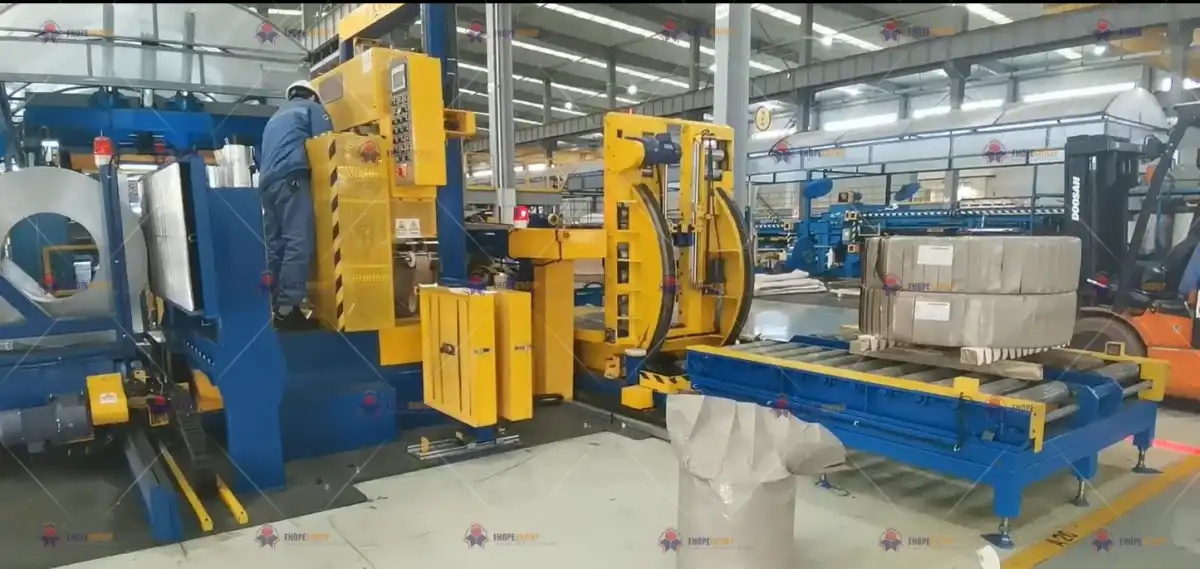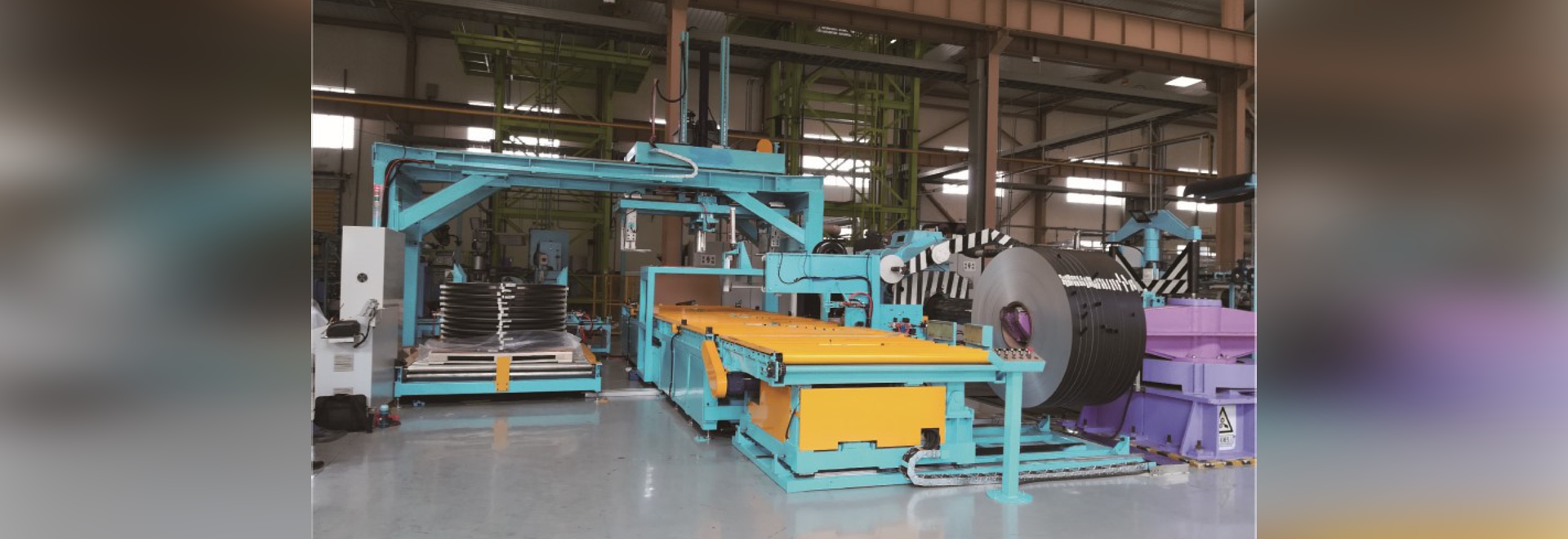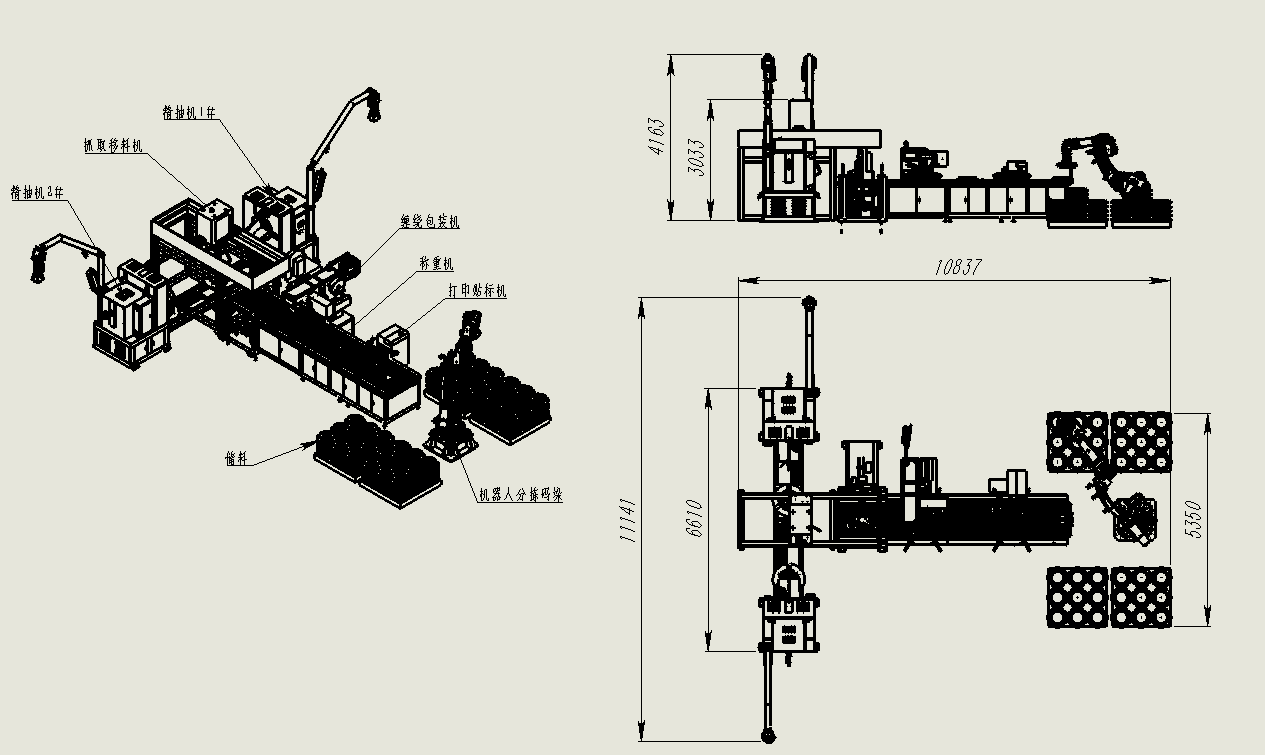Are you a Canadian plant manager looking at your aging coil packing line? You see the rising maintenance costs, the unpredictable downtime, and the ever-present pressure on your budget. It feels like a constant battle to maintain output without overspending. The equipment seems to drain your team's time and the company's profits. I understand this feeling because I have been there myself, both on the factory floor and as a factory owner.
A modern coil packing line's Return on Investment (ROI) for Canadian plant managers goes far beyond a simple payback calculation. It is a strategic investment that directly reduces operational costs through material and labor savings, significantly boosts uptime and product quality, and helps meet Canada's stringent safety and environmental standards. The true return is found in enhanced operational stability and long-term profitability.

Calculating this ROI is not just about the machine's price tag. It is about understanding how each feature of a new system impacts your entire operation. A new machine is not just a piece of equipment; it is a tool to solve bigger problems like high costs, production bottlenecks, and safety concerns. To see the full picture, we need to look at specific areas where a modern solution delivers real, measurable value. Let's break down the key questions you should be asking.
How does modern coil packing directly reduce operational costs?
Do you look at the monthly spending on packing materials and labor and see the numbers climbing? Are the energy bills for your packing line higher than they should be? These costs add up quickly. They eat into your margins month after month. You know you need a solution that cuts these daily expenses without risking the quality of your packed coils.
Modern coil packing machines directly reduce operational costs by using technology to optimize material usage, automate manual processes to lower labor expenses, and run on energy-efficient motors and systems. This results in measurable savings on consumables like stretch film, wages for your team, and your plant's utility bills, starting from the first day of operation.

Deeper Dive: Pinpointing Your Cost Savings
Let's move beyond general statements and look at the specific mechanics of cost reduction. For a plant manager in Canada, where operating costs are high, these details are not just interesting—they are critical for making a solid business case.
Slashing Material Waste
The biggest, most immediate saving often comes from material consumption. Your old wrapper might be using far more stretch film than necessary. Modern systems attack this problem with precision engineering.
- Pre-Stretch Technology: The key is the pre-stretch ratio. A standard machine might stretch the film to 150%. A modern, well-engineered system can achieve ratios of 250% to 300%. This means every meter of film you buy covers more surface area. For example, a 300% pre-stretch turns one meter of film into four meters. This alone can cut your film consumption by 50-70%.
- Precise Overlap Control: Older machines often rely on manual settings or have significant overlap variation. New systems use PLCs and sensors to control the wrap with great accuracy. You can set the exact overlap you need for product protection, and the machine will repeat it perfectly for every coil. No more wasted film from excessive, uncontrolled overlapping.
Here is a simple comparison:
| Feature | Old Packing Machine (10+ years) | Modern SHJLPACK Machine | Impact on Costs |
|---|---|---|---|
| Pre-Stretch Ratio | 100% - 150% (or none) | 250% - 300% | Drastically reduces film usage per coil. |
| Overlap Control | Manual, inconsistent | PLC-controlled, precise | Eliminates waste from too much overlap. |
| Film Tearing | Frequent due to poor tension | Rare due to smooth tension control | Reduces downtime and wasted film tails. |
Optimizing Labor and Safety
Labor is a significant cost, especially in Canada. Automation in modern packing lines directly addresses this. An old setup might require two or three workers to manually position, wrap, and move coils. A new, automated line can often be monitored by a single operator who oversees the entire process. This isn't about replacing people; it's about reallocating your skilled workforce to more valuable, less repetitive tasks. This shift also has a huge impact on safety. Manual wrapping and handling are leading causes of back injuries and repetitive strain. Automation removes your team from these physically demanding tasks, which can lead to lower WCB premiums and fewer lost-time incidents.
Winning the Energy Battle
Energy costs are a major challenge. Older packing machines, especially those with hydraulic systems, are energy hogs. They run continuously, even when a coil is not present. Modern machines are designed for efficiency. They use Variable Frequency Drives (VFDs) that adjust motor speed to the exact need, consuming much less power. They also feature energy-saving modes, automatically powering down parts of the machine during idle periods. In a country with carbon pricing, every kilowatt-hour you save is a direct contribution to your bottom line and your company's environmental goals.
Can new coil packing lines truly improve uptime and reliability?
Is unexpected downtime on your packing line causing production bottlenecks and delaying shipments to your customers? Do you feel like your maintenance team spends more time fixing the old wrapper than performing preventive work on other critical equipment? An unreliable packing line can hold your entire plant's output hostage and damage your reputation for on-time delivery.
Yes, new coil packing lines absolutely improve uptime and reliability. They are constructed with robust, high-quality components, designed for durability, and often include sensors for predictive maintenance. They also feature modular designs, which means if a part does fail, it can be replaced quickly. This engineering focus translates directly to achieving—and even exceeding—ambitious uptime targets like 95%.

Deeper Dive: The Engineering Behind 95% Uptime
Achieving high uptime is not an accident. It is the result of deliberate design and engineering choices. When a machine is built to run, it runs. When I was starting my factory, I learned this lesson the hard way. A cheap machine with poor components caused constant headaches. Here is what you should look for to ensure reliability.
The Anatomy of a Reliable Machine
The foundation of reliability is build quality. You can see it and feel it.
- Heavy-Duty Construction: A modern, industrial-grade machine uses a heavy-duty steel frame. This minimizes vibration, which is a primary cause of component wear and failure over time.
- Premium Components: The difference between a machine that lasts five years and one that lasts fifteen is often in the parts you can't easily see. We insist on using world-class components like Siemens or Allen-Bradley PLCs for control, and high-quality bearings from brands like SKF or FAG. These parts are designed for millions of cycles in harsh industrial environments. An older machine might have generic or worn-out parts that are far more likely to fail unexpectedly.
- Simplified Mechanics: Good design is often simple design. Modern machines often replace complex, maintenance-heavy systems (like hydraulics) with cleaner, more reliable electric servo motors. Fewer moving parts and fewer potential leak points mean fewer things can go wrong.
From Reactive to Predictive Maintenance
The biggest shift in modern manufacturing is moving from fixing what's broken to preventing it from breaking. This is where technology plays a huge role.
- Integrated IoT Sensors: New machines can be equipped with sensors that monitor key indicators of machine health. Vibration sensors on motors can detect bearing wear long before it leads to failure. Temperature sensors can alert you to overheating. Cycle counters can tell you exactly when a component is due for a scheduled replacement based on actual usage, not just a calendar date.
- Actionable Data: This data is fed to your control panel or MES system. Instead of your maintenance team guessing, they get a clear alert: "Motor 3 vibration is high. Inspect bearing at next scheduled stop." This allows you to schedule repairs during planned downtime, not in the middle of a critical production run. This is the very definition of proactive, intelligent maintenance.
The Real Cost of Downtime: A Canadian Plant's Reality
Let's put this in perspective. For a steel facility in Canada, the cost of unplanned downtime is enormous. It's not just the cost of the repair part.
| Downtime Cost Component | Estimated Hourly Cost (Example) | Description |
|---|---|---|
| Lost Production Value | $5,000 - $20,000+ | Value of coils you could not produce and ship. |
| Idle Labor | $500 - $1,500 | Wages for the upstream and downstream teams waiting for the line. |
| Expedited Freight | $1,000+ | Cost to rush late orders to customers. |
| Reputation Damage | Incalculable | The long-term cost of being seen as an unreliable supplier. |
When you look at these numbers, the investment in a reliable machine with predictive capabilities pays for itself not by saving a few dollars on maintenance, but by preventing catastrophic losses from unplanned stops.
You have done the math on film savings and calculated the labor reduction. The numbers look good. But do you have a feeling that you're still missing part of the bigger picture? There are powerful, hidden benefits that don't always show up on a simple ROI spreadsheet but have a massive impact on your plant's profitability, culture, and long-term success.
The hidden ROI of a new coil packing line is found in three critical areas: improved worker safety, which directly reduces insurance premiums and lost-time incidents; enhanced product protection, which lowers damage claims and boosts customer satisfaction; and better environmental compliance, which helps you avoid fines and strengthens your brand's reputation in the eco-conscious Canadian market.

Deeper Dive: Uncovering the Value That Lasts
These "hidden" factors are often what separate a good investment from a great one. They contribute to a more resilient, efficient, and respected operation. In my journey, I found that focusing on these areas created a stronger business.
Protecting Your People and Your Premiums
In Canada, workplace safety is not optional; it is a legal and moral obligation. A modern packing line is engineered with safety as a top priority.
- Engineered Safety: This includes physical guarding to prevent access to moving parts, light curtains that immediately stop the machine if a person enters a hazardous zone, and clearly marked, accessible emergency stops. These are not add-ons; they are integrated into the machine's design and control system.
- Eliminating Hazardous Tasks: The biggest safety improvement comes from automation. Manually lifting film rolls, bending to strap coils, and working close to powerful rotating equipment are all high-risk activities. An automated system does these jobs, moving your employees into a safer role as system operators and monitors.
- The Financial Impact: A safer workplace has a direct financial return. Fewer injuries mean fewer WSIB/WCB claims, which leads to lower annual premiums. It also improves morale and shows your team that you value their well-being, which can reduce employee turnover.
Delivering Perfect Coils, Every Time
What is the cost of a single coil damaged in transit? It's the cost of the material, the production time, the freight to the customer, the return freight, and the administrative time to process the claim. More importantly, it's a hit to your customer's confidence.
- Consistent, Protective Wrapping: A modern machine applies the wrapping material with consistent tension and placement, creating a secure, weather-resistant package. It cocoons the coil, protecting it from moisture, dust, and physical impact during shipping across Canada's vast distances or overseas.
- Reduced Customer Claims: Better packaging directly leads to fewer damage claims and rejected shipments. This is a direct revenue protector. When your customers know that a coil from your plant will always arrive in perfect condition, you become their preferred supplier. This reliability is a powerful competitive advantage.
Meeting and Exceeding Environmental Mandates
The business landscape in Canada is increasingly shaped by environmental regulations and customer expectations. A modern machine helps you meet these challenges.
- Material Reduction: As we discussed, pre-stretch technology means you use significantly less plastic film. This is not just a cost saving; it is a measurable reduction in your environmental footprint.
- Adaptability to Greener Materials: New packing lines can be designed or adapted to work with more sustainable materials as they become available, such as films with higher recycled content or even biodegradable options.
- Corporate Responsibility: Being able to demonstrate a commitment to sustainability is no longer just "nice to have." It can be a deciding factor for large customers with their own corporate social responsibility goals. Investing in efficient technology is a clear, demonstrable way to show that you are a responsible industry partner.
My Final Insight: Seeing Beyond the Price Tag
When I was starting my own factory, every dollar was precious. The temptation to buy the cheapest piece of equipment was strong. It's a natural instinct for any business owner or manager under budget pressure. But I learned a very hard lesson, very quickly: a low price today can lead to crippling costs tomorrow. Are you focusing only on the initial investment, or are you looking at the total value?
My years of experience, from the factory floor to the owner's office, have taught me this: the true value of a packing machine is not in its purchase price. It's in its total cost of ownership and, most importantly, in the partnership you form with the supplier. A machine that is engineered for your specific needs, from a supportive partner who understands your challenges, will deliver a far greater ROI over its lifetime than the cheapest option on the market.

Deeper Dive: A Lesson Forged in Experience
This philosophy is the foundation of SHJLPACK. It comes from my own journey and the challenges I faced. It's why our slogan is "TOTAL SOLUTION FOR WRAPPING MACHINE," not just "We sell machines."
My Journey from Engineer to Owner
I started my career as an engineer in a packing machine factory. I saw firsthand how different machines were built. I also saw which ones kept running and which ones caused constant frustration for the operators and maintenance crews. Later, when I established my own factory, I had to make the same investment decisions you are facing now. I remember buying a cheaper strapping machine for one of our first lines. I thought I was being smart and saving capital. It turned out to be a disaster. The machine jammed constantly, the parts were hard to get, and the supplier offered little support. The downtime cost me far more in lost production and customer trust than I had "saved" on the purchase price. That experience was painful, but it taught me the most valuable lesson of my career: invest in quality, and invest in partners.
What a True Partnership Looks Like
This is what a C-level executive or a savvy plant manager like Javier Morales in Mexico looks for. It's what every Canadian plant manager should demand. A true partner doesn't just email you a quote.
- They Analyze Your Line: A partner wants to understand your entire process. They ask about your coil sizes, weights, production speed, and the layout of your plant. They want to see how material flows to and from the packing station. This detailed analysis ensures the solution fits perfectly into your operation.
- They Customize the Solution: Your plant is unique. A true partner doesn't offer a one-size-fits-all machine. They customize it. Maybe you need a special conveyor system, an integrated weighing and labeling station, or the ability to handle a very wide range of coil diameters. A partner engineers the solution for your problem.
- They Provide Total Support: The relationship begins, it doesn't end, with the sale. This means expert installation and commissioning. It means thorough training for your Canadian operators and maintenance team in a way they understand. It means having accessible spare parts and technical support that can quickly solve a problem. It means being a resource you can call in two years to ask about integrating new sensor technology.
The Question You Must Ask
So, when you evaluate a new coil packing line, I urge you to change the primary question. Don't just ask, "How much does it cost?" Instead, ask the supplier, "How will this machine and your partnership help me achieve my goals of 95% uptime, a 10% reduction in energy use, and an overall 8% cut in operating costs?" Frame the discussion around solving your biggest business challenges. The right partner will have clear, confident answers. They will talk about reliability, efficiency, and support. That is how you find the best ROI—not on a price list, but on your production floor for years to come.
Conclusion
Investing in modern coil packing is a powerful strategic move for achieving operational excellence, boosting profitability, and ensuring sustainable, long-term growth in Canada's demanding and competitive industrial market.





